|
Contents
(Within the text click a heading to return here)
- A bit of History
- Colossus
- performance
- hardware details
- operating cycles
- programming
- The Rebuild
- Valves
Colossus was designed and built at the Post Office Research Laboratories at Dollis Hill in North London in 1943 by a team led by Dr Tommy Flowers to help Bletchley Park in decoding the intercepted German telegraphic cipher traffic enciphered using the Lorenz SZ42 cipher machine.
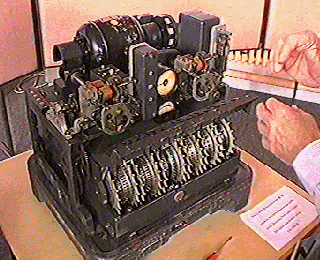
This cipher machine enciphered electrical teleprinter signals which used the international 5 bit Baudot teleprinter code. It enciphered the input plain text by adding to it successively two characters before transmission. Because this addition was bit by bit modulo 2, at the receiving end with the Lorenz machine set to the same start position, the same two characters were added again to the received characters revealing the original plain text. This scheme had been developed in America by Gilbert Vernam in 1918. Vernam used two tapes of random characters to generate the additional characters. With the same tapes at each end set to the same start position this system was unbreakable. The Germans decided that the distribution of these key tapes presented too great an operational problem and the Lorenz machine uses a complicated mechanical gearing and cam system to generate a pseudo random sequence with very long period and 10^19 complexity. They thought this was good enough to ensure unbreakability, it wasn't!
The German high command thought that the Lorenz machine was completely unbreakable and used it for their most secret messages, literally from Hitler to his generals and between generals. The interception and deciphering of these messages gave Generals Eisenhower and Montgomery vital information prior to and after D Day in 1944.
Colossus was the world's first large electronic valve programmable logic calculator, not just one but ten of them were built and operational in Bletchley Park the home of Allied WW II codebreaking.
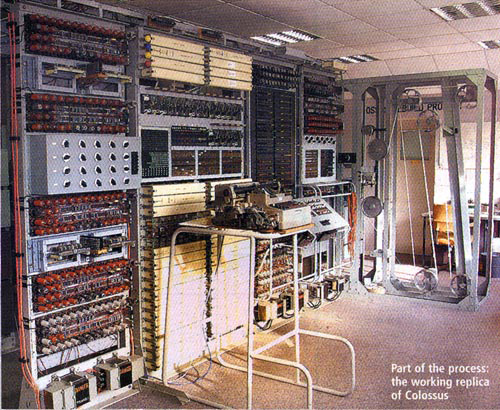
Colossus found the wheel settings used by the German Lorenz machine operator for a particular message. When these had been found, which took about two hours, they were plugged up on the Tunny machine. It was this machine which actually deciphered the message.
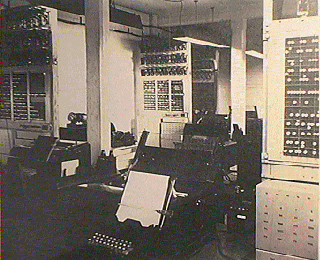
This is the Tunny room in Bletchley Park in 1945.
Colossus is not a stored-programme computer. It is hard-wired and switch-programmed, just like ENIAC. Because of its parallel nature it is very fast, even by today's standards. The intercepted message, punched on to ordinary teleprinter paper tape, is read at 5,000 characters per second. The sprocket holes down the middle of the tape are read to form the clock for the whole machine. This avoids any synchronisation problems: whatever the speed of the tape, that's the speed of Colossus. Tommy Flowers once wound up the paper tape drive motor to see what happened. At 9,600 characters per second the tape burst and flew all over the room at 60 mph! It was decided that 5,000 cps was a safe speed.
At 5,000 cps the interval between sprocket holes is 200 microsecs. In this time Colossus will do up to 100 Boolean calculations simultaneously on each of the five tape channels and across a five character matrix. The gate delay time is 1.2 microsecs which is quite remarkable for very ordinary valves. It demonstrates the design skills of Tommy Flowers and Allen Coombs who re-engineered most of the Mark 2 Colossus.
Colossus is so fast and parallel that a modern PC programmed to do the same code-breaking task takes as long as Colossus to achieve a result!
Input: cipher text punched onto 5 hole paper tape read at 5,000 characters per second by optical reader
Output: Buffered onto relays: Typewriter printing onto paper roll
Processor: memory 5 characters of 5 bits held in a shift register. Clock speed 5kc/s derived from input tape sprocket holes. Internally generated bit streams totalling 501 bits in rings of lengths equal to the number of mechanical lugs on each of the 12 Lorenz wheels. A large number of pluggable logic gates. 20 decade counters arranged as 5 by 4 decades.
2,500 valves. Power supplies +200v to -150v at up to 10A. Power consumption 4.5KWatt
Size: Two banks of racks 7ft 6inches high by 16ft wide spaced 6 ft apart. Bedstead, 7ft 6inches high 4ft wide by 10ft long
The basic machine cycle: read a character from tape, get bits from bit stream generators, perform up to 100 logic operations, clock result into decade counters.
The cycle determined by the input tape: The intercepted enciphered text tape is joined into a continuous loop with about 150 blank characters in the join. Specially punched start and stop holes indicate the beginning and end of the cipher text.
On receipt of start hole pulse: Start bit stream generators and send sampling pulses to reader output. Execute basic machine cycle until receipt of stop hole pulse: Staticise counter states onto relays. After a delay, reset counters and reset bit stream generators to a new start position.
All programmes hard wired, some permanently, some pluggable. Conditional jumping possible between alternative programmes depending on counter outputs.
Work on the rebuild started in 1993 with the collection of all available information about Colossus, including a series of official photographs taken in 1945.
The first stage was to produce accurate machine drawings of the frames for Colossus (all the original machine drawings had been burnt in 1960). This involved three months of eye-strain pouring over the photographs and using 3D projections to transfer the details to a CAD system, EasyCad running on a 486 PC.
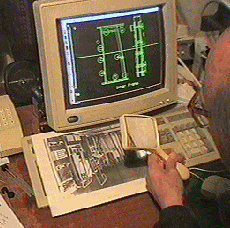
Next problem was the optical paper tape reader system. The details of this are not shown in any of the photographs. However I managed to locate Dr Arnold Lynch who designed the reader system in 1942. Although well into his 80's Dr Lynch came to my house and using my CAD system we re-engineered the reader system to his original specifications. Then I built it and here it is.
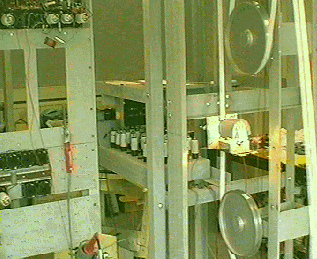 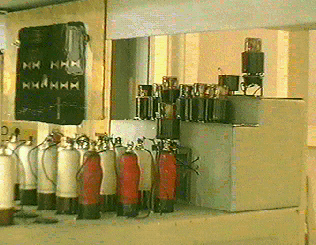
It uses original Colossus hard vacuum photocells, shown here on the left and a mask onto which the image of the tape is projected by a Colossus lens.
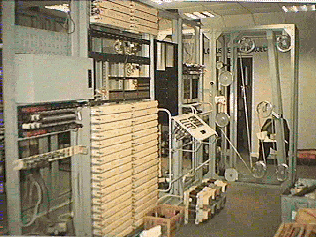 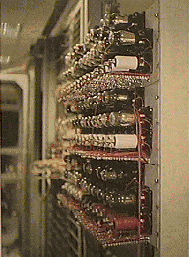
All the racks are now in place, and here are some of the decade counters.
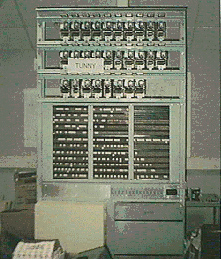
We are also rebuilding the Tunny machine.
The state of Colossus
The whole machine has been working at 2 bit level since the switch-on by HRH The Duke of Kent on 6th June 1996, Tommy Flowers in the wheel chair.
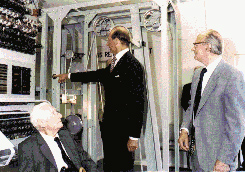
Since that time, more wartime information has been released by the National Archive in the USA. This has allowed us to work out a lot more circuits and also the detailed programmes used.
We are taking the opportunity to rewire some of the racks using proper laced Post Office wring so that the final machine will look even more like the original.
We expect the whole machine to be running by year 2,000. Colossus is Y2K compliant (it doesn't have a clock!)
I have enough valves (tubes!) to complete Colossus but would like to build up a reserve so that it can be kept going for a few more years so more valves: EF36, EF37 or EF37A pentodes, 6J5 triodes, 6V6 tetrodes and GT1C gas filled triode thyratrons. The 6J5's and 6V6's should be the large glass versions to look right.
Come and see the Colossus Rebuild, the Lorenz machine and codebreaking exhibitions and much more at The National Museum of Computing TNMoC on the Bletchley Park Site. TNMoC need specific valves for all of their rebuild activities, please contact them if you can assist with their projects.
Anthony E Sale, FBCS
|